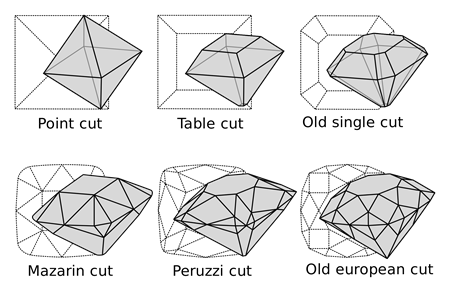Diamond Cut
One of the many reasons why diamonds remain a highly desirable and pricy product is their astounding ability to transmit light and to sparkle. A diamond isn’t “born” sparkly, but becomes so by the ability of the master cutter to cut the diamond with precise artistry and workmanship.

In contrast to what many people may think, cut refers not to a diamond’s shape, but to its proportions, symmetry and polish. It is often regarded as the most crucial of the diamond 4Cs (which also include color, clarity and carats) since a diamond cut has the biggest influence over how a diamond looks; cut grade is all about how well a diamond's facets interact with light.
Polish and symmetry are two important aspects of the cut: polish refers to the smoothness of the diamond's facets, and the symmetry describes the alignment of the facets.
The choice of diamond cut is decided after analyzing several factors: the shape of the rough stone, location of inclusions (internal flaws in the diamond), the preservation of carat weight, and the popularity of certain diamond shapes. The most popular of diamond cuts is the modern round brilliant. Fancy cuts, which come in a variety of shapes, are also strong among jewelry lovers.
According to the GIA, of all the diamond 4Cs, cut is the most complex and technically difficult to analyze. As most diamond jewelry is characterized by the shape of the round brilliant, the GIA calculates the proportions of those facets that influence the diamond's face-up appearance when determining the stone’s cut grade. These proportions allow it to evaluate how successfully a diamond interacts with light to create brightness (Internal and external white light reflected from a diamond), fire (the scattering of white light into all the colors of the rainbow) and scintillation(the amount of sparkle a diamond produces, and the pattern of light and dark areas caused by reflections within the diamond).
The GIA Diamond Cut Scale for standard round brilliant diamonds contains 5 grades, ranging from Excellent to Poor.

